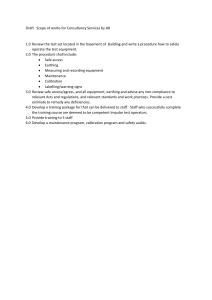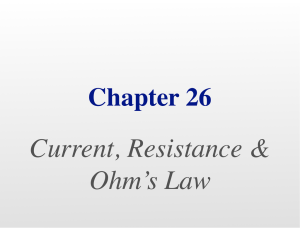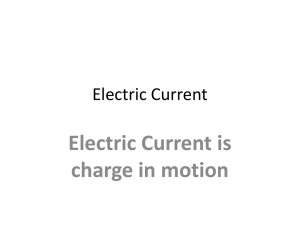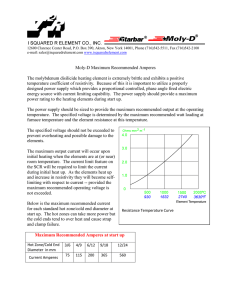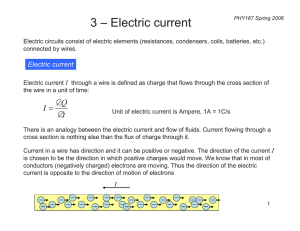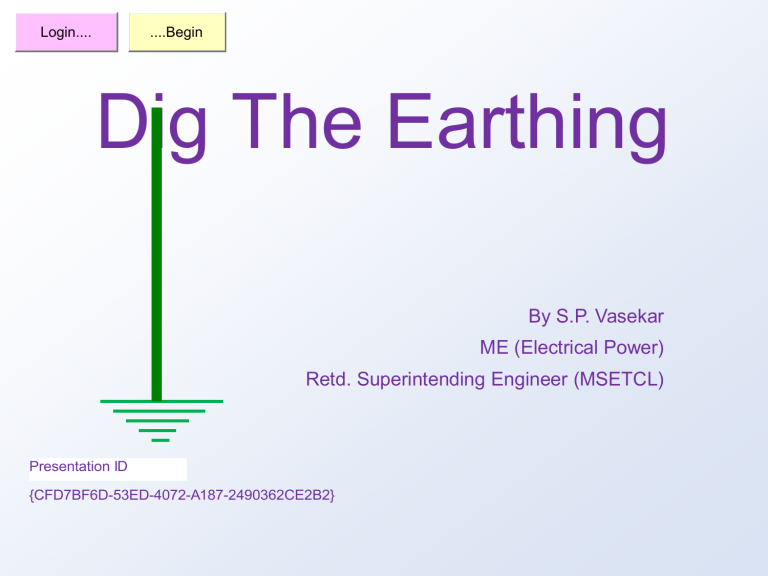
Login....
....Begin
Dig The Earthing
By S.P. Vasekar
ME (Electrical Power)
Retd. Superintending Engineer (MSETCL)
Presentation ID
{CFD7BF6D-53ED-4072-A187-2490362CE2B2}
Purpose….
• Purpose of this presentation is to introduce you to,
“Finite Element Method” software, with some
examples about earth pit modeling.
• Often it is possible to model the complex physical
system with available software and generate some
output, but it is always difficult to analyze and
interprets the output if we are not well conversant
with the fundamentals of the physical system.
• Hence in this presentation only some very basic
physical systems are modeled and analyzed.
• Some examples of the basic physical system is
copper rod having square cross section, single
earth pit, measurement for earth pit resistance etc.
What is included • This presentation includes simulation of very
basic things of electrical engineering. These
simulations will help in understanding of the
earthing
• Or we may say simulation of earthing improves
our knowledge about use of the simulation
software.
• For creating these simulations, open source
software FEMM is used.
• The FEMM is depend upon Octave which is
again a open source software and is 95%
substitute for Matlab (as claimed by users of
Octave)
Closed loop circuit formed by two earthing electrodes
• Let in a open ground, there are two earth pits separated by a
distance of 100 meters. Now if a DC voltage source is connected
to form the closed loop with this earth pits. Let it is observed that
to maintain the DC current of 100 Amp. Voltage required is 1370
V. Now be ready to response for an MCQ with next slide.
Response Count
0
Stop
{FC662F63-D739-4D60-B07A-00545203BC0D}
Volatge required to maintain a current of 100 Amp. in a closed loop formed by two earthing electrodes
separated by 100 m is 1370 V. If distance increased to 200 m, what will be voltage to maintain same current.
A). Slightly more than 2740 V.
B). Slightly less than 2740 Volts.
C). Slightly More than 1370 Volts.
D). Slightly less than 1370 Volts
{FC662F63-D739-4D60-B07A-00545203BC0D}
Your Responses
Opt-D
25%
Opt-A
25%
Opt-C
25%
Opt-B
25%
Back to school
• Either you have guessed it correctly by your experience or you may be
surprises how this happens.
• To get it understood we will try to simulate the physical situation.
• However before to simulating above said physical situation, we will
simulate some very simple case, like rod of the copper.
• Let us try to simulate 1.0 cm x 1.0 cm square rod of copper having the
length 10 cm, supplied with 1.0 volts.
• As a preparation of simulation process actively, please submit your
responses for few MCQ.
Response Count
4
Stop
{D312F031-0387-4061-99A7-097D2B23B50B}
What is the formula for resistance of metalic bar of known cross section area, length and resistivity?
A). ....
C). ....
ρx
𝐶𝑆 𝐴𝑟𝑒𝑎
𝑙𝑒𝑛𝑔𝑡ℎ
1 𝑙𝑒𝑛𝑔𝑡ℎ
x
ρ 𝐶𝑆 𝐴𝑟𝑒𝑎
B).
....
D).
....
ρx
𝑙𝑒𝑛𝑔𝑡ℎ
𝐶𝑆 𝐴𝑟𝑒𝑎
1 𝐶𝑆 𝐴𝑟𝑒𝑎
x
ρ 𝑙𝑒𝑛𝑔𝑡ℎ
{D312F031-0387-4061-99A7-097D2B23B50B}
Your Responses
Opt-D
25%
Opt-A
25%
Opt-C
25%
Opt-B
25%
Formula for resistance
•Resistance is proportional to resistivity of
the material.
•Resistance is directly proportional to
length of material.
•It is inversely proportional to cross
section area of the material.
•Ω = ρ x
𝑙𝑒𝑛𝑔𝑡ℎ
𝐶𝑆 𝐴𝑟𝑒𝑎
Response Count
4
Stop
{C7456EFA-05A5-4DA5-862A-09BB6CADAD83}
What is the unit for resistivity in MKS (SI) system?
Ω
C). ....
Ω.m
.m
B).
....
Ω/m
D).
....
Ω
A). ....
/m
{C7456EFA-05A5-4DA5-862A-09BB6CADAD83}
Your Responses
Opt-D
25%
Opt-A
25%
Opt-C
25%
Opt-B
25%
Unit for resistivity ρ (Rho)
Ω
2
𝑚
m
= ρ 𝑥
ρ = Ω.m
𝑙𝑒𝑛𝑔𝑡ℎ
𝐶𝑆 𝐴𝑟𝑒𝑎
Response Count
4
Stop
{787517D5-DD5B-443B-8511-1983ABDC9206}
What is resitivity for the copper?
A). ....
C). ....
1.7241 Ω.m
580 Ω.m
B).
....
D).
....
58000000 Ω.m
1.7241e-8 Ω.m
{787517D5-DD5B-443B-8511-1983ABDC9206}
Your Responses
Opt-D
25%
Opt-A
25%
Opt-C
25%
Opt-B
25%
Resistivity of Copper
• Copper is very good conductor of electricity
• In MKS system (Now SI), resistivity of copper is
resistance of 1mx1mx1m block of copper.
• It must me very low.
• Hence correct answer is 1.7241e-8 Ω.m
• Conductivity is inverse of resistivity and for copper
it is approximately 58000000 siemens.
• NOTE: Do not confuse with writing style e-8 it
means exponent -8 and e-8 means number e raise
to power -8
Response Count
4
Stop
{6AC0A23C-62A7-4618-8E47-1EAFB098231F}
What will be the current through a copper bar of cross section area of 1cmx1cm having length of 10 cm, if 1
volt is applied between its square faces?
A). 58000 Amp.
B). 5800 Amp.
C). 580000 Amp.
D). Other than this.
{6AC0A23C-62A7-4618-8E47-1EAFB098231F}
Your Responses
Opt-D
25%
Opt-A
25%
Opt-C
25%
Opt-B
25%
Current through copper bar.
• Consider a copper bar of 1 cm x 1 cm having
10 cm length.
• Resistivity for copper is 1.72e-8 Ω.m
• Hence to apply formula R = ρ.(Length/Area) we
have to find out area and length in m2 and m
respectively
• Area = 0.01*0.01 = 0.0001 m2
• Length = 0.1 m
• Hence R = 1.72e-8*(0.1/0.0001)
• I = V/R = 1/(1.72e-8*1000)
• I = 58000 Amp.
Introduction to FEMM
• Practically it is impossible to inject the current
58000 Amp.
• But though the simulation is meaningful for
some practical situation, we will first try to
simulate this theoretical case.
• We will use FEMM software for this simulation.
• FEMM is Finite Element Method Magnetics
• Though it is primarily developed for problem in
magnetics field, it can be used for
• static electricity.
• Heat flow problem.
• Current flow problem.
Introduction to FEMM
• Here screen shot of FEMM work place is shown
• There are two types of object modelling (Problem Type)
•
•
Planar
Axisymmetric
Planar Modelling
Object to be simulated
Model and Properties
to be Selected
Geometry to be drawn
Axisymmetric Modelling
Simulation for current flowing through a bar of copper
having cross section area of 1cmx1cm and length of 10
cm.
Show The Video
Duration 11:44 min
Plotting the voltage chart in FEMM
• Using chart tool and contour we can plot the
chart for selected quantity
1
• Can you guess the shape for voltage chart.
Please response to an MCQ.
Response Count
4
Stop
{250AA840-7B0B-48CC-9F65-806A5430D1D1}
If voltage applied between oposit edges of the square metalic bar, what will be the shape of the curve
ploted with voltage on Y axis and length on X axis.
A).
....
B).
....
C).
....
D).
....
{250AA840-7B0B-48CC-9F65-806A5430D1D1}
Your Responses
Opt-D
25%
Opt-A
25%
Opt-C
25%
Opt-B
25%
Plotting the voltage chart in FEMM
Resistance of earth pit
• Before simulating the resistance of the earth
pit, let us go through some MCQs.
• This will help this group for a better
understanding of the earth pit and there by
simulation too.
Response Count
4
Stop
{D27B08F6-A358-4419-80A4-9132BF9FC32F}
Which of the following sentence about "Earth Resistivity" and "Earth Resistance" is most correct from the
engineer's point of view.
A). 'Earth Resistivity' and 'Earth Resistance'
both are general terms.
B). 'Earth Resistivity' and 'Earth Resistance'
both are scientific terms.
C). 'Earth Resistivity' is a scientific term
whereas 'Earth Resistance' is a general term.
D). 'Earth Resistivity' is a general term
whereas 'Earth Resistance' is a scientific
term.
{D27B08F6-A358-4419-80A4-9132BF9FC32F}
Your Responses
Opt-D
25%
Opt-A
25%
Opt-C
25%
Opt-B
25%
Earth Resistivity and Earth Resistance
Earth Resistivity: It is scientific
method of measuring electrical
properties for earth
Earth Resistance: Needs to
be refer specific to some
object (earth pit)
Resistance of single earth electrode
When we refer simply earth resistance, it is in context with some
particular situation, generally resistance of single earth electrode. When we
refer the resistance of single earth electrode, we are referring effective
resistance between that electrode and a zero potential hemi-spherical
(cylindrical and hemi-spherical) surface at infinity.
Response Count
4
Stop
{0DBD0076-C49C-4273-BB19-C20C2A34E33A}
What are usual and exceptional values of soil resistivity.
A). Usual: 1.0 to 10.0 Ohm.m, Exceptional
10.0 to 100.0 Ohm.m
B). Usual: 0.01 to 0.001 Ohm.m, Exceptional
0.001 to 0.0001 Ohm.m
C). Usual: 10 to 100 Ohm.m, Exceptional 100
to 1000 Ohm.m
D). Usual: 10 to 1000 Ohm.m, Exceptional
1000 to 10000 Ohm.m
{0DBD0076-C49C-4273-BB19-C20C2A34E33A}
Your Responses
Opt-D
25%
Opt-A
25%
Opt-C
25%
Opt-B
25%
Response Count
4
Stop
{E47F3932-8176-49FE-B037-FB3A8DA90850}
What is the normal value of earth pit resistance in ehv s/s as you observed
A). 0.5 to 3.0 Ohms measured with earth
grid(mat).
B). 0.5 to 1.0 Ohms measured after
separating from earth grid.
C). 30 to 50 Ohms after separating from the
earth grid.
D). 1.0 to 10.0 Ohms measured with earth
grid.
{E47F3932-8176-49FE-B037-FB3A8DA90850}
Your Responses
Opt-D
25%
Opt-A
25%
Opt-C
25%
Opt-B
25%
Effective resistance of earth mat in EHV S/S
• For the fault current when transformer HV and LV earth pits connected to
earth mat, all earth pits get connected in parallel and overall resistance
decreases.
Response Count
4
Stop
{651398C3-F41A-4FF2-A8A9-B0EDF53768D0}
Can we assess (calculate) the resistance of the earth pit separated from the earth grid (mat) before actual
measurement.
A). Always.
B). After knowing construction details of the
earth pit.
C). After knowing construction details of the
earth pit and soil resistivity.
D). Never.
{651398C3-F41A-4FF2-A8A9-B0EDF53768D0}
Your Responses
Opt-D
25%
Opt-A
25%
Opt-C
25%
Opt-B
25%
Response Count
4
Stop
{F0BFE962-F83F-4DB1-86C2-2CD01DB268A8}
What is the formula for earth pit resistance formed by a metallic rod/pipe?
A). (Rho/2*PI*L)*Ln(2L/d)
B). (Sigma/2*PI*L)*Ln(2L/d)
C). (Rho/2*PI*L)*(2L/d)
D). (Sigma/2*PI*L)*(2L/d)
{F0BFE962-F83F-4DB1-86C2-2CD01DB268A8}
Your Responses
Opt-D
25%
Opt-A
25%
Opt-C
25%
Opt-B
25%
Resistance of earth rod
Show The Video
Duration 14:39 min
Response Count
4
Stop
{C49A7158-EDE7-423C-9996-69F059344AA6}
Method of soil resistivity measurement known by the name of -
A). Wenner
B). Webber
C). Warner
D). Ohms
{C49A7158-EDE7-423C-9996-69F059344AA6}
Your Responses
Opt-D
25%
Opt-A
25%
Opt-C
25%
Opt-B
25%
Paper published by Frank Wenner in 1915
Open….
Response Count
4
Stop
{E6F16A5F-5C81-465F-9BF1-133773456914}
In the measurement of soil resistivity by four peg method (Wenner) with equal distance "a" between pegs
inserted at a depth of d, the relation between a and d shall be -
A). A)
d shall be less than 1/10 th of a.
C). C) does not matter how much d is with
respect to a.
B). B)
d shall be more than 1/10 th of a.
D). D)
a and d shall be equal
{E6F16A5F-5C81-465F-9BF1-133773456914}
Your Responses
Opt-D
25%
Opt-A
25%
Opt-C
25%
Opt-B
25%
Response Count
4
Stop
{34F359C1-4ED6-44C7-A99A-3D6FAD75446D}
In the measurement of soil resistivity by four peg method (Wenner) with equal distance "a" between pegs, if
"a" is more -
A). results are accurate.
B). require less power to inject current.
C). we get an estimate of the soil resistance of
the deeper layer.
D). only require more power to inject current,
results that remain unchanged..
{34F359C1-4ED6-44C7-A99A-3D6FAD75446D}
Your Responses
Opt-D
25%
Opt-A
25%
Opt-C
25%
Opt-B
25%
Wenner method for measurement of earth resistivity:
Distance between rods
Response Count
4
Stop
{0D6537F7-0283-46A6-8D63-AFE3EBB64E60}
While measuring the resistance of an earthing pit, positions of current and voltage pegs are such that -
A). Inline, with the current injection peg at the
far end.
B). Inline, with voltage measuring peg at the
far end.
C). Inline, the position of current and voltage
peg does not matter.
D). Anywhere.
{0D6537F7-0283-46A6-8D63-AFE3EBB64E60}
Your Responses
Opt-D
25%
Opt-A
25%
Opt-C
25%
Opt-B
25%
Voltage distribution due to current injection during
measurement of earthing electrode resistance.
R
C1 P1 P2 C2
Response Count
4
Stop
{3A53EDDF-C0E4-43E1-B026-7BEAFAD08081}
In three peg method for measurement of earth pit resistance in EHV S/S -
A). Current Peg 10 m. Voltage Peg 5 m.
B). Current 10 to 20 times the depth of the
electrode. Voltage peg midway.
C). Voltage peg 10 m, Current Peg 5 m
D). Distance or sequence does not matter
{3A53EDDF-C0E4-43E1-B026-7BEAFAD08081}
Your Responses
Opt-D
25%
Opt-A
25%
Opt-C
25%
Opt-B
25%
Distance of current peg and potential peg
Distance of current peg and potential peg
Simulation of Earthing Electrode
• FEMM Software used for simulating the
earthing electrode
• Axisymmetric Geometry considered.
• Remote boundary voltage considered as zero
volt
• Earthing Rod voltage considered as 50 V.
• Simulated current through rod is calculated by
using integral over contour.
• Results are matched with theoretical values.
Creation of Axisymmetric Geometry
Simulation of earthing electrode – FEMM Model
Geometry
Simulation of earthing electrode – FEMM Solution
Simulation of earthing electrode – FEMM Analysis
Simulation of earthing electrode – Comparing simulation
results with calculated values.
Simulation model for two earth electrodes, Source and Sink- Current
View
Simulation model for two earth electrodes, Source and SinkVoltage View
ETAP GroundMat software output
Conclusion….
• On the same line, it is possible to
simulate and analyse various
earthing models in software.
• Such modelling will improve our
understanding about the earthing.
• When simulations carried out by
some professional software and
person it will help in solving the
earthing issues.
Close Conne
